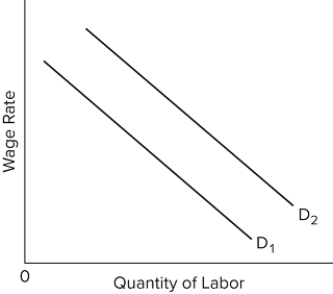A) should hire more labor because this will increase profits.
B) should hire more labor, although this may either increase or decrease profits.
C) is currently hiring the profit-maximizing amount of labor.
D) is selling its product in an imperfectly competitive market.
Correct Answer

verified
Correct Answer
verified
Multiple Choice
A competitive employer will hire inputs up to the point where the
A) marginal product of the input reaches a maximum.
B) price of the input equals the price of the output.
C) price of the input equals the marginal product of the input.
D) price of the input equals the marginal revenue product of the input.
Correct Answer

verified
Correct Answer
verified
Multiple Choice
In the market for superstars,
A) earnings reflect pricing power rather than marginal revenue product.
B) small differences in talent get magnified into huge differences in pay.
C) entry and exit rarely occur.
D) product demand is typically highly elastic.
Correct Answer

verified
Correct Answer
verified
Multiple Choice
The marginal resource cost of labor for a firm refers to the
A) additional cost of each additional unit of labor employed.
B) additional cost of producing each extra unit of output.
C) same concept as the marginal cost of the firm.
D) same concept as the marginal revenue product of a firm.
Correct Answer

verified
Correct Answer
verified
Multiple Choice
The demand for labor would most likely become less inelastic as a result of
A) a decrease in the elasticity of the demand for the product that the labor produces.
B) a decrease in the time for employers to make technological changes or purchase new equipment.
C) a decrease in the proportion of labor costs to total costs.
D) an increase in the proportion of labor cost to total costs.
Correct Answer

verified
Correct Answer
verified
Multiple Choice
In percentage terms, which of the following occupations is expected by the U.S. Bureau of Labor Statistics to be the fastest growing from 2016 to 2026?
A) solar photovoltaic installers
B) statisticians
C) nurse practitioners
D) postal service sorters and processors
Correct Answer

verified
Correct Answer
verified
Multiple Choice
Marginal revenue product describes the
A) output produced by the last unit of labor employed.
B) revenue received for the last unit of output produced.
C) price a consumer paid for the last unit of output produced.
D) revenue received for the additional output produced by the last unit of labor employed.
Correct Answer

verified
Correct Answer
verified
Multiple Choice
The rising demand for health-care industry workers is due to the following factors, except
A) aging of the U.S. population.
B) rising income levels in the U.S.
C) the continued presence of health insurance for U.S. consumers.
D) decreasing prices of labor in the health-care industry.
Correct Answer

verified
Correct Answer
verified
Multiple Choice
The change in a firm's total revenue that results from hiring an additional worker is measured by
A) the marginal product.
B) the marginal revenue.
C) the marginal revenue product.
D) the average revenue product.
Correct Answer

verified
Correct Answer
verified
Multiple Choice
Marginal resource cost is
A) the increase in total resource cost associated with the production of one more unit of output.
B) the increase in total resource cost associated with the hire of one more unit of the resource.
C) total resource cost divided by the number of inputs employed.
D) the change in total revenue associated with the employment of one more unit of the resource.
Correct Answer

verified
Correct Answer
verified
True/False
The more elastic the demand for a product, the less elastic will be the demand for the resources employed in producing it.
Correct Answer

verified
Correct Answer
verified
Multiple Choice
 Use the graph to answer the question about the labor resource market faced by producers of good X. What will shift D ₂ to D ₁?
Use the graph to answer the question about the labor resource market faced by producers of good X. What will shift D ₂ to D ₁?
A) A decrease in the price of a substitute input (if the output effect > substitution effect)
B) An increase in the price of a substitute input (if the substitution effect > output effect)
C) An increase in the price of a substitute input (if the output effect > substitution effect)
D) A decrease in the price of a complementary resource
Correct Answer

verified
Correct Answer
verified
Multiple Choice
According to the marginal productivity theory of resource demand, the labor-demand schedule for a producer selling in a purely competitive market is
A) the same as the marginal resource cost schedule.
B) the same as the marginal productivity schedule.
C) the same as the marginal revenue product schedule.
D) independent of the value of the product being produced.
Correct Answer

verified
Correct Answer
verified
Multiple Choice
Resource X has many close substitutes, whereas resource Y has no close substitutes. Other things equal, we would expect
A) the demand for resource Y to be more elastic than the demand for resource X.
B) resources X and Y to be close substitutes.
C) resource X to be more expensive than resource Y.
D) the demand for resource X to be more elastic than the demand for resource Y.
Correct Answer

verified
Correct Answer
verified
Multiple Choice
The general rule for hiring any input (say, labor) in the profit-maximizing amount is MRC = MRP. This rule takes the special form W = MRP (where W is the wage rate) when the
A) labor supply curve is upsloping.
B) supply of labor is inelastic.
C) firm is hiring labor under purely competitive conditions.
D) firm is hiring labor under imperfectly competitive conditions.
Correct Answer

verified
Correct Answer
verified
True/False
Increased resource productivity will, ceteris paribus, increase a firm's demand for an input.
Correct Answer

verified
Correct Answer
verified
Multiple Choice
A decline in the price of resource A will
A) increase the demand for complementary resource B.
B) shift the demand curve for A to the left.
C) shift the demand curve for A to the right.
D) reduce the demand for complementary resource B.
Correct Answer

verified
Correct Answer
verified
Multiple Choice
 Refer to the given table. Which of the following best represents the labor demand schedule for this firm?
Refer to the given table. Which of the following best represents the labor demand schedule for this firm?
A) ![]()
B) ![]()
C) ![]()
D) ![]()
Correct Answer

verified
Correct Answer
verified
Multiple Choice
A change in a factor's price will have a greater effect on the quantity of the factor demanded the
A) smaller the change in the factor's price.
B) smaller the factor's share of total cost of production.
C) more elastic is the demand for the product the factor helps to make.
D) more inelastic is the demand for the product the factor helps to make.
Correct Answer

verified
Correct Answer
verified
Multiple Choice
 The table gives marginal product data for resources a and b. The output of these independent resources sells in a purely competitive market at $1 per unit. Assuming the prices of resources a and b are $5 and $8 respectively, what is the least costly combination of resources for the firm to employ in producing 192 units of output?
The table gives marginal product data for resources a and b. The output of these independent resources sells in a purely competitive market at $1 per unit. Assuming the prices of resources a and b are $5 and $8 respectively, what is the least costly combination of resources for the firm to employ in producing 192 units of output?
A) 2 of a and 6 of b
B) 6 of a and 2 of b
C) 4 of a and 3 of b
D) 3 of a and 4 of b
Correct Answer

verified
Correct Answer
verified
Showing 61 - 80 of 359
Related Exams